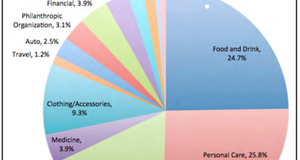From Elon Journal of Undergraduate Research in Communications VOL. 5 NO. 2Feminine Agendas: The Historical Evolution of Feminism as Reflected in the Content of American Women's MagazinesPeriod II: Feminine Independence v. Domesticity in the 1870s to 1970sDespite the increase in female civic participation throughout the early to mid-19th century, the first major developments in the overall American feminist movement did not occur until the late 19th and early 20th centuries. Coming on the heels of urban industrialism and the emergence of more liberal, socialist politics, the first wave of feminism set its goal of opening up opportunities for women, mainly through suffrage. “Women’s rights pioneers first identified 1848 and 1920 as the critical turning points in women’s struggle to achieve sexual equality.” Elizabeth Cady Stanton and Susan B. Anthony were instrumental in organizing the Seneca Falls Convention, where 300 men and women rallied to the cause of equality for women.11 The onslaught of World War II (1939-1945) was a unique period in the history of the United States, and was one of the biggest changes in lifestyles to average American citizens. Now more than ever, women were relied upon to take care of their homes and children while men were responsible for protecting the country. This emphasis on female domesticity lasted through the 1940s and continued into the 1950s as the picturesque American Dream lifestyle became popular, and the content of women’s magazines during this time mirrored this shift in gender roles. According to Waller-Zuckerman, the number of magazine consumers expanded enormously between 1890 and World War I, which roughly coincides with the first wave of the feminist movement. She asserted that the economic and demographic changes during this time period caused women to “search for reliable prescriptive manuals that would tell them how to lead a proper feminine life,” indicating that magazines were expected to set a specific agenda for how women should live their lives.12 Waller-Zuckerman also wrote that, as women’s roles shifted from producer to consumer during World War II and into the 1950s, “reading and learning about new products in the marketplace became part of the housewife’s job,” indicating there were a variety of ways magazines promoted a certain agenda that wasn’t quite on par with the feminist ideology at this time.13 Walker compiles an extensive volume of content taken from popular women’s magazines from 1940 to 1960 dealing with such topics ranging from women at the workplace to marriage and motherhood. She also includes a section that delves into criticism aimed at American women’s magazines during this time period. In her introduction, Walker writes that many “criticized the magazines for being repetitious, for condescending to readers by assuming that women were responsible for correcting all flaws in both household and marriage, or by creating within their pages worlds far removed from the realities of women’s lives,” asserting that American women were not entirely pleased with the domesticity-based agenda they found during this specific time period.14 Pierce responded to Waller-Zuckerman’s and Walker’s claims by saying there were still ways in which women’s magazines in the early 20th century led to a more female-empowering society. In the context of Progressive Era reform work, suffrage and World War I, “arguments for change gained prominence and broader acceptability, in part through the way women’s magazines represented social issues for their readers and represented readers themselves.”15 She wrote that many magazines published a continuous flow of information about women’s expanded sphere of activities and commentary about the effects of these transformations. Several magazines even began to link a woman’s responsibilities as a mother with her rights as a citizen, turning motherhood into a subject of public significance rather than private sentiment. This showed that many women’s periodicals sought to influence public opinion rather than simply advise homemakers, according to Pierce, indicating that some early to mid-20th century magazines did indeed have the feminist agenda in mind. Due to the abundance of domestically-focused magazines published throughout the 1920s to 1950s as well as the drastic political changes occurring in the country during the Vietnam War (1959-1975), women’s magazines of the 1960s and 1970s strived to reflect these societal changes by presenting women with an agenda more focused on independence, namely through the presentation of women in the workplace and in higher education. Additionally, the second wave of the feminist movement began in the 1960s and went on well until the 1990s. This wave unfolded in the context of the anti-war and civil rights movements and the growing self-consciousness of a variety of minority groups around the world. In this phase, sexuality and reproductive rights were dominant issues, as well as equal rights in the workplace. Magazines began to pick up on these changes, showing women working instead of residing in their homes as housewives and portraying women being successful. Flora mirrored McCall’s insight into the way that women were presented in 19th century women’s magazine fiction when she methodically examined women’s status in magazine fiction in the 1970s. Magazine fiction of this decade was varied in its presentation of women as passive and dependent, especially depending on whether the fiction was geared towards working class or middle class women. Flora asserts that, overall, “intelligence is a quality in women that counters the image of passivity” in this type of content.16 Additionally, women’s intelligence was mentioned increasingly between 1970 and 1975 and usually presented positively. Middle-class women’s occupational statuses were presented more positively by magazine fiction, which made a “shift away from defining the worth of women through unpaid domestic functions.”17 Flora’s analysis takes a unique perspective by examining how women’s magazines presented feminism based on class differences, which is something that largely defines feminism in the 20th century. Starr wrote about a few women’s magazines founded in the 1970s that combated the traditional notions of feminine identity by presenting more independent ideals. Whereas traditional women’s magazines catered to women at home (Good Housekeeping) or young women (Mademoiselle), “ ‘working women’ were seen to have a different mix of interests: more interested in news about progressive changes in gender roles and in workplace success, and less interested in cooking, housekeeping, home décor, fashion, and dating.”18 Two prime examples of these magazines were Working Woman and Working Mother, both of which had rapidly growing circulation in the 1970s and early 1980s, at a time when women were eager to think and read more about how to revise their identities. These magazines borrowed an abundance of ideas from academics, activists, business consultants and/or successful role models about how women could form new identities. “Yet the magazines were not simply relaying information that was obvious in content and accuracy . . . they were creating ideas and suggestions that were grounded in existing knowledge and that they thought readers would find valuable and effective.”19 These magazines and their overall themes indicate a switch in emphasis from domesticated housewives to career-driven women. Thus, Starr’s analysis is notable for examining changes in how magazines were presenting feminism at this crucial time in the United States. Period III: The “I’m-Not-A-Feminist-But” Generation in the 1980s to PresentThe 20th century had brought about a number of radical changes in the perception of women in American society. By the end of the 1970s and beginning of the 1980s, women found themselves in a much more equal position to men than they had in previous decades. The election of Ronald Reagan in 1980, however, led the national public agenda to shift markedly toward the Right. This gave rise to the third wave of feminism, commonly called the New Feminist Movement, in which “the major challenges of the 1980s included maintaining public approval for positions that a popular president and the federal government no longer supported,” such as defending feminist organizations and their members from direct, sometimes violent, attack.20 At this time, the term ‘feminist’ began to gain a bad connotation due to the controversy surrounding the intensity of the new movement. Even many women felt they had gained enough in terms of equality and that the feminist movement was becoming rather exhaustive, so women’s interests were no longer focused on one singular goal, such as workplace equality. As their interests became much broader, magazines responded by offering as much diverse content as possible. Specifically, popular women’s magazines, which focus on topics like pop culture, fashion and beauty—they continue to be popular today—became the main source of information and entertainment for many women. Taylor took a unique look at these popular women’s magazines in her analysis of their support of the “I’m-Not-a-Feminist-But” generation, which she described as individuals who support the core principles of existing feminism, but do not identify themselves as a feminist. Despite their ambiguity, Taylor says these individuals became the main readers of popular women’s magazines who, like their readers, “have benefitted from more than forty years of feminism, but they do not consider themselves feminist.”21 She said that these types of magazines, with some of the leading titles including Redbook, Family Circle and Better Homes & Gardens, provided an important place for feminism and popular culture to cohabit. In Forever Feminine, Ferguson argued that women’s magazines had become “ ‘about more than women and womanly things, they are about femininity itself — as a state, a condition, a craft, and an art form which comprises a set of practices and beliefs.’ ”22 Though third-wave feminists condemned these periodicals for supporting an image of women that was too “fluffy” and “almost childlike,”23 the magazines continued to boast impressive circulation numbers to this day: Redbook averaged a circulation of well over 2 million in 2007.24 According to Taylor, popular women’s magazines aim to encourage their readers to bring about their own personal transformations, “even as the magazines cultivate more traditional messages of femininity and domesticity” — a contradiction felt by those women who claim “I’m not a feminist but,” as well as by third-wave feminists.25 Taking all this into consideration, it would appear that Taylor’s research could support the idea that modern magazines support feminism without forcing readers to accept a strict feminist agenda, which may be what modern women prefer in their reading. Winship’s novel, Inside Women’s Magazines, gave a great deal of information on how feminism has been represented throughout the entire history of women’s magazines in the United States, with special consideration to how magazines of the late 20th century transitioned to the magazines we know today. Specifically, she connects with Taylor’s ideas on magazines not declaring themselves as feminist, but supporting feminine ideals for readers instead. She then transitions into discussing women’s magazines that became popular in the late 20th century that are still around today, such as Cosmopolitan and Woman’s Own. Though these magazines are often praised for being more progressive in the way they present women’s issues, Winship argued, however, that “commercial magazines are not and do not wish to be part of the women’s movement,” but they “constantly hold out something that is possible for individual women to achieve. As one Woman’s Own article put it, ‘I am my own woman’ . . . It is on that unspoken assumption that magazines are premised; it is a knowledge intimately shared between women.”26 This idea implies that women no longer felt they needed to read a magazine that specifically set out to tell them how to live a feminist life — feminist ideals were now much more firmly engrained into the daily lives and mindsets of modern women. But Winship also says that this attitude allowed many magazines to start gradually falling away from feminist values altogether. Specifically discussing Cosmo’s ideas of feminism, she opined that there are problems with its presentation of feminism, one of which being that the magazine “gives unusual prominence to men’s views — about feminism, their contributions are barbed.”27 Though popular magazines gave female readers a variety of different ideas that they could choose to accept, some scholars of mass media seem to suggest that female readers tend to share a feeling of ambivalent pleasure about these publications. “They enjoy the magazines, and may at times learn bits and pieces — ideas for how to look or behave, as well as more straightforward information about health, popular culture or social issues. At the same time, these readers would not really argue that the magazines are ‘perfect’ or ‘ideal’ in terms of how they address women.”28 This presents an interesting view of women’s magazines during this time period as something that women could choose whether or not to indulge in, but no longer something they relied upon for guidance, as they were viewed in previous decades. On the other hand, Winship wrote that the rise of magazines like Everywoman and Women’s Review was a more authentically feminist response to magazines like Cosmo in the 1980s. She wrote, “Everywoman, focusing on news and current affairs and largely steering clear of ‘the personal,’ pitches itself towards women who might not think of themselves as feminists but who are interested in a wider range of issues than the women’s glossies deal in.”29 This idea largely reflects how women’s magazines continue to function today. Though there are lots of periodicals that are criticized for their unfair representation of women and feminist values, there are just as many, if not more, magazines that strive to address these issues by presenting female values in an empowering light. In general, women’s magazines today offer “a confusing and contradictory set of ideas,”30 but many scholars argue that the public should work on accepting and merging the values presented in popular women’s magazines — “to be assertive, confident, sexual, ‘true to yourself,’ demanding rights and pleasures” — and the more “traditional” feminist view.31 It is a debate that will likely continue for quite some time, but despite any controversy that may linger on, women’s magazines have come a long way in terms of positively presenting feminist values as feminism has evolved over the course of American history.Continued on Next Page » Suggested Reading from Inquiries Journal
Inquiries Journal provides undergraduate and graduate students around the world a platform for the wide dissemination of academic work over a range of core disciplines. Representing the work of students from hundreds of institutions around the globe, Inquiries Journal's large database of academic articles is completely free. Learn more | Blog | Submit Latest in Women's & Gender Studies |



















